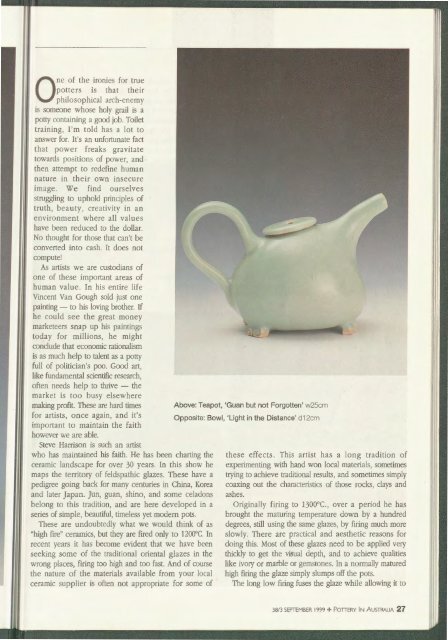Pottery In Australia Vol 38 No 3 September 1999
Create successful ePaper yourself
Turn your PDF publications into a flip-book with our unique Google optimized e-Paper software.
One of the ironies for true<br />
potters is that their<br />
philosophical arch-enemy<br />
is someone whose holy grail is a<br />
potty containing a good job. Toilet<br />
training, I'm told has a lot to<br />
answer for. It's an unfortunate fact<br />
that power freaks gravitate<br />
towards positions of power, and<br />
then attempt to redefine human<br />
nature in their own insecure<br />
image. We find ourselves<br />
struggling to uphold principles of<br />
truth, beauty, creativity in an<br />
environment where all values<br />
have been reduced to the dollar.<br />
o thought for those that can't be<br />
converted into cash. It does not<br />
compute!<br />
As artists we are custodians of<br />
one of these important areas of<br />
human value. <strong>In</strong> his entire life<br />
Vincent Van Gough sold just one<br />
painting - to his loving brother. If<br />
he could see the great money<br />
marketeers snap up his paintings<br />
today for millions, he might<br />
conclude that economic rationalism<br />
is as much help to talent as a potty<br />
full of politician's poo. Good art,<br />
like fundamental scientific research,<br />
often needs help to thrive - the<br />
market is too busy elsewhere<br />
making profit. These are hard times<br />
for artists, once again, and it's<br />
important to maintain the faith<br />
however we are able.<br />
Steve Harrison is such an artist<br />
who has maintained his faith. He has been charting the<br />
ceramic landscape for over 30 years. <strong>In</strong> this show he<br />
maps the territory of feldspathic glazes. These have a<br />
pedigree going back for many centuries in China, Korea<br />
and later Japan. Jun, guan, shino, and some celadons<br />
belong to this tradition, and are here developed in a<br />
series of simple, beautiful, timeless yet modern pots.<br />
These are undoubtedly what we would think of as<br />
"high fire" ceramics, but they are fired only to 1200°C. <strong>In</strong><br />
recent years it has become evident that we have been<br />
seeking some of the traditional oriental glazes in the<br />
wrong places, firing too high and too fast. And of course<br />
the nature of the materials available from your local<br />
ceramic supplier is often not appropriate for some of<br />
Above: Teapot, 'Guan but not Forgotten' w25cm<br />
Opposite: Bowl, 'Light in the Distance' d12cm<br />
these effects. This artist has a long tradition of<br />
experimenting with hand won local materials, sometimes<br />
trying to achieve traditional results, and sometimes simply<br />
coaxing out the characteristics of those rocks, clays and<br />
ashes.<br />
Originally firing to 1300°C., over a period he has<br />
brought the maturing temperature down by a hundred<br />
degrees, still using the same glazes, by firing much more<br />
slowly. There are practical and aesthetic reasons for<br />
doing this. Most of these glazes need to be applied very<br />
thickly to get the visual depth, and to achieve qualities<br />
like ivory or marble or gemstones. <strong>In</strong> a normally matured<br />
high firing the glaze simply slumps off the pots.<br />
The long low firing fuses the glaze while allowing it to<br />
<strong>38</strong>/3 SEPTEMBER <strong>1999</strong> + POTTERY IN A USTRALIA 27

















